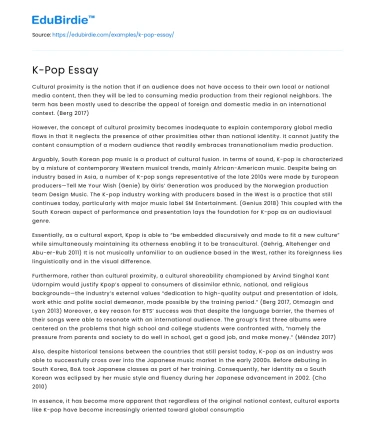Cultural proximity is the notion that if an audience does not have access to their own local or national media content, then they will be led to consuming media production from their regional neighbors. The term has been mostly used to describe the appeal of foreign and domestic media in an international context. (Berg 2017)
However, the concept of cultural proximity becomes inadequate to explain contemporary global media flows in that it neglects the presence of other proximities other than national identity. It cannot justify the content consumption of a modern audience that readily embraces transnationalism media production.
Save your time!
We can take care of your essay
- Proper editing and formatting
- Free revision, title page, and bibliography
- Flexible prices and money-back guarantee
Arguably, South Korean pop music is a product of cultural fusion. In terms of sound, K-pop is characterized by a mixture of contemporary Western musical trends, mainly African-American music. Despite being an industry based in Asia, a number of K-pop songs representative of the late 2010s were made by European producers—Tell Me Your Wish (Genie) by Girls’ Generation was produced by the Norwegian production team Design Music. The K-pop industry working with producers based in the West is a practice that still continues today, particularly with major music label SM Entertainment. (Genius 2018) This coupled with the South Korean aspect of performance and presentation lays the foundation for K-pop as an audiovisual genre.
Essentially, as a cultural export, Kpop is able to “be embedded discursively and made to fit a new culture” while simultaneously maintaining its otherness enabling it to be transcultural. (Gehrig, Altehenger and Abu-er-Rub 2011) It is not musically unfamiliar to an audience based in the West, rather its foreignness lies linguistically and in the visual difference.
Furthermore, rather than cultural proximity, a cultural shareability championed by Arvind Singhal Kant Udornpim would justify Kpop’s appeal to consumers of dissimilar ethnic, national, and religious backgrounds—the industry’s external values “dedication to high-quality output and presentation of idols, work ethic and polite social demeanor, made possible by the training period.” (Berg 2017, Otmazgin and Lyan 2013) Moreover, a key reason for BTS’ success was that despite the language barrier, the themes of their songs were able to resonate with an international audience. The group’s first three albums were centered on the problems that high school and college students were confronted with, “namely the pressure from parents and society to do well in school, get a good job, and make money.” (Méndez 2017)
Also, despite historical tensions between the countries that still persist today, K-pop as an industry was able to successfully cross over into the Japanese music market in the early 2000s. Before debuting in South Korea, BoA took Japanese classes as part of her training. Consequently, her identity as a South Korean was eclipsed by her music style and fluency during her Japanese advancement in 2002. (Cho 2010)
In essence, it has become more apparent that regardless of the original national context, cultural exports like K-pop have become increasingly oriented toward global consumption, especially in our current technological climate dominated by social media.






 Stuck on your essay?
Stuck on your essay?

